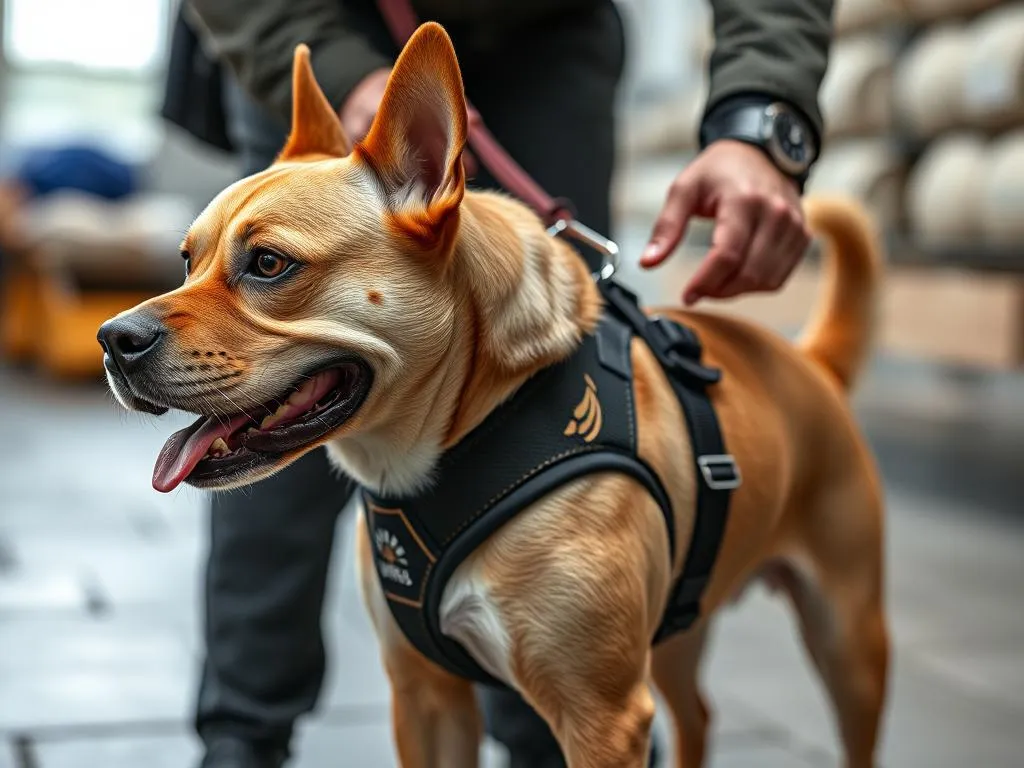
Introduction
As a dog owner, ensuring your furry friend is safe and comfortable during walks is paramount. One of the best ways to achieve this is by using a dog harness. Unlike collars, which can put pressure on a dog’s neck, a harness distributes weight across the chest and back, reducing the risk of injury. In this article, we will guide you through how to put on a dog harness effectively, making the experience seamless for both you and your pet.
Understanding Dog Harnesses
Types of Dog Harnesses
When it comes to dog harnesses, there are several styles to choose from, each designed for specific needs:
- Front-clip harnesses: These harnesses have a leash attachment at the front, which helps discourage pulling by redirecting your dog’s attention towards you.
- Back-clip harnesses: Featuring a clip on the back, these are great for calm dogs and those who do not pull excessively.
- No-pull harnesses: Designed specifically for dogs that tend to pull on the leash, these harnesses include features that tighten slightly around the dog’s chest when they pull, discouraging the behavior.
- Specialty harnesses: This category includes options like service dog harnesses, which often come with additional features like reflective strips and identification patches.
Choosing the Right Harness for Your Dog
Selecting the appropriate harness for your dog is essential for their comfort and safety. Here are some factors to consider:
- Size: Make sure to measure your dog’s chest and neck before purchasing a harness. Most brands provide sizing charts to help you choose the right fit.
- Breed: Different breeds may have unique body shapes. For example, a bulldog may require a different style than a Dachshund.
- Age: Puppies may need adjustable harnesses as they grow, while older dogs may benefit from harnesses designed for senior pets.
- Fitting and Comfort: Always prioritize comfort. A well-fitted harness should be snug but not too tight. Look for materials that are soft and breathable.
Some popular brands to consider are Ruffwear, PetSafe, and Kurgo.
Preparing Your Dog for Harnessing
Getting Your Dog Comfortable with the Harness
Before you can successfully put a harness on your dog, it’s crucial to ensure they are comfortable with it. Here are some techniques to help your dog acclimate:
- Introduction Techniques: Show your dog the harness and allow them to sniff it. Let them explore it on their own terms.
- Positive Reinforcement Methods: Use treats and praise to create a positive association with the harness. For instance, reward your dog every time they show interest in the harness.
Ensuring a Calm Environment
Creating a stress-free environment is vital for successful harnessing. Here are some tips to achieve this:
- Choose the Right Time: Pick a moment when your dog is calm, such as after a walk or play session.
- Limit Distractions: Ensure that the area is quiet and free from distractions to help your dog focus on you.
Step-by-Step Guide on How to Put on a Dog Harness
Step 1: Gather Your Supplies
Before beginning, gather the necessary items:
- Dog harness: Make sure it is the right type and size for your dog.
- Treats: Keep some treats handy to reward your dog during the process.
- Leash: Have a leash ready to attach to the harness once it’s on.
Step 2: Positioning the Harness
Understanding how to position the harness correctly is key:
- Identify the Front and Back: Most harnesses have a distinctive front and back. Ensure you know which side goes where.
- Ensure the Harness is Right Way Up: Check that the harness is not twisted and that all straps are in the correct position.
Step 3: Adjusting the Harness
Proper adjustment is crucial for safety and comfort:
- Adjust Straps: Make sure to adjust the harness straps so that it fits snugly. It should not be too tight or too loose.
- Check for Proper Fitting: A well-fitted harness should allow you to fit two fingers between the harness and your dog’s body.
Step 4: Securing the Harness on the Dog
Now, let’s dive into the methods for putting the harness on your dog:
- Over the Head Method:
- Hold the harness open and guide your dog’s head through the neck opening.
- Pull the harness down over your dog’s body.
-
Fasten any clips or buckles.
-
Step-In Method:
- Lay the harness on the ground with the back straps open.
- Encourage your dog to step into the harness.
- Pull the harness up and secure it around the dog’s back.
Tips for Keeping the Dog Still: If your dog is fidgety, use treats to keep their attention. You can also have someone gently hold them still if needed.
Step 5: Final Checks
After putting the harness on, it’s essential to ensure everything is secure:
- Ensure the Harness is Secure: Check that all clips are fastened and that the harness is not twisted.
- How to Test the Fit: Use the two-finger rule: you should be able to fit two fingers comfortably between the harness and your dog’s body.
Common Mistakes to Avoid
Incorrect Fitting
One of the most common issues is an improperly fitted harness:
- Signs of an Improperly Fitted Harness: Look for signs of discomfort, such as chafing or difficulty walking.
- How to Correct Fitting Issues: If the harness is too loose, readjust the straps. If it’s too tight, consider getting a different size.
Forcing the Harness
Patience is key when introducing a harness to your dog:
- Why Patience is Key: Forcing a harness onto a dog can lead to anxiety and resistance in the future.
- Alternative Methods if the Dog Resists: If your dog is not cooperating, take a break and try again later, using treats as encouragement.
Not Using the Harness Properly
Using a harness incorrectly can lead to safety issues:
- Common Usage Errors: Avoid attaching a leash to the collar while the harness is on, as this can cause confusion and potential injury.
- Importance of Supervision: Always supervise your dog while they are wearing a harness, especially in new environments.
Tips for Successful Harness Training
Building Positive Associations
Creating a positive experience around the harness is essential:
- Using Treats and Praise Consistently: Reward your dog every time they wear the harness, helping them associate it with good things.
- Gradually Increasing Time Wearing the Harness: Start with short durations and gradually increase the time as your dog becomes more comfortable.
Incorporating the Harness into Walks
Transitioning to outdoor settings requires some preparation:
- How to Transition from Home to Outdoor Settings: Begin with short walks close to home, gradually increasing distance as your dog becomes accustomed to the harness.
- Ensuring Safety While Walking with a Harness: Always keep an eye on your dog’s behavior. If they seem uncomfortable, reassess the fit or take a break.
Regularly Checking the Fit
As dogs grow and change, their harness fit may need adjustments:
- Importance of Reassessing Fit: Regularly check the harness fit, especially if your dog has had a growth spurt or has lost weight.
- Signs that a Harness Needs Adjustment or Replacement: Look for wear and tear, frayed straps, or a loose fit.
Conclusion
Using a dog harness is a fantastic way to ensure your pet’s safety and comfort during walks. By understanding the different types of harnesses, preparing your dog effectively, and following the step-by-step guide provided, you can ensure a smooth harnessing experience. Remember to be patient and keep practicing; both you and your dog will benefit from this essential skill. With time and positive reinforcement, wearing a harness can become a routine part of your dog’s life.
FAQs
Why should I use a harness instead of a collar?
A harness distributes pressure away from the neck, reducing the risk of injury and providing better control, especially for dogs that tend to pull.
How do I know if the harness fits my dog correctly?
A correctly fitted harness should allow you to fit two fingers between the harness and your dog’s body. It should be snug but not too tight.
Can I leave the harness on my dog all day?
While it’s generally safe for short periods, it’s best to remove the harness when not in use to prevent chafing or discomfort.
What should I do if my dog doesn’t like the harness?
Use treats and positive reinforcement to create a positive association. Gradually introduce the harness, starting with short sessions.
How do I clean and maintain a dog harness?
Follow the manufacturer’s instructions for cleaning. Most harnesses can be hand-washed or machine-washed on a gentle cycle. Always air dry to maintain the material integrity.









